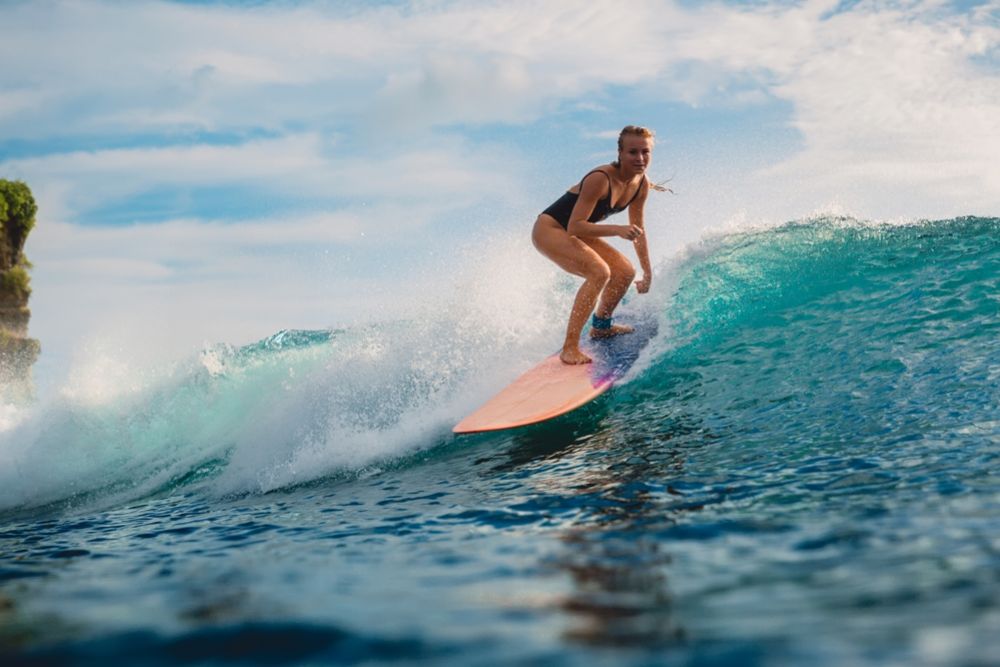Surfing is as much about reading waves and honing technique as it is about having the right board under your feet. From paddling ease to maneuverability on the face of a wave, a well-matched surfboard can significantly advance your skills—or hold you back if it’s ill-suited. Whether you’re new to surfing or ready to jump from a funboard to a more performance-oriented shape, choosing a board that aligns with your ability level (and wave conditions) is key to continuous growth.
1. Why Board Choice Matters
The ocean might provide the waves, but your surfboard dictates how well you harness their energy. Starting with the wrong board can lead to frustration, stalled progress, and even injuries. Conversely, selecting the right shape, volume, and length can help you catch waves more easily and allow you to refine your skills faster.
- Paddling Efficiency: A board with sufficient volume floats you better, saving energy and letting you catch waves earlier.
- Stability vs. Maneuverability: Wider, thicker boards tend to be more stable—ideal for beginners—whereas narrower boards excel in speed and agility, favored by advanced surfers.
- Wave Size and Power: Softer, slower waves often require more volume and a flatter rocker, while steep, powerful waves can pair well with boards that allow snappy maneuvers.
2. Understanding Basic Board Terminology
Before diving into specific board types, get familiar with the core design elements—length, width, thickness, rocker, and volume. A rudimentary understanding helps you decipher manufacturers’ specs and surf shop advice.
- Length: Measured from nose to tail, influencing paddle speed and stability. Longer boards are generally more stable and easier to paddle, but can be less maneuverable.
- Width: The broadest point of the board, affecting stability and planning surface. Wider boards are more stable, narrower boards are more agile in turns.
- Thickness: How “thick” the board is, often measured at the thickest point. Thicker boards have more buoyancy, aiding paddling and wave-catching, but may hinder very tight maneuvers.
- Rocker: The curve of the board from nose to tail. Flatter rockers plane quickly on small waves but can pearl (dig the nose) in steeper waves. More rocker helps with steeper drops and sharper turns but may slow paddling speed.
- Volume (in Liters): Possibly the most telling measurement, indicating how much foam the board holds (i.e., its buoyancy). Beginner boards require higher volume; experienced surfers might seek a lower-volume board for better performance and control.
3. Board Types for Different Skill Levels
Each board category (longboard, funboard, shortboard, fish, etc.) meets different needs, from easy wave entry to advanced maneuvers. Understanding how each style supports a particular skill level (and wave type) helps narrow your search.
For Beginners and Low-Intermediate Surfers
- Soft-Top Foam Boards
- Overview: Thick, wide, and buoyant, often used in surf schools. The foam deck reduces the risk of injuries.
- Pros: Very stable and forgiving, easy wave-catching, safer in crowded lineups.
- Cons: Not as maneuverable, can be bulky when trying to progress in turns.
- Ideal Conditions: Small, mushy waves.
- Skill Level: True beginners and surfers transitioning from the earliest learning phase.
- Longboards (9–10+ ft.)
- Overview: Characterized by length and broad, rounded noses, offering classic “cruising” style.
- Pros: Exceptional stability, easy paddle, and wave-catching. Ideal for smaller, weaker waves. Great for practicing footwork and trimming.
- Cons: Hard to duck dive, less agile on steep or powerful waves.
- Ideal Conditions: Gentle, rolling waves under chest-high.
- Skill Level: Beginners to advanced surfers who love the smooth, traditional style.
- Funboards / Mini-Mals (7–8 ft.)
- Overview: A cross between a longboard and a shortboard—often 7–8 feet, with generous width and thickness.
- Pros: More maneuverable than a longboard, but still stable and easy for wave entry. Good transitional board as you refine pop-up technique.
- Cons: Heavier than a shortboard, might feel sluggish in big or hollow surf.
- Ideal Conditions: Waist- to head-high waves, moderate conditions.
- Skill Level: Low to mid-intermediate surfers progressing from foamies or longboards.

For Intermediate and Advanced Surfers
- Shortboards (Typically 5’8″–6’6″)
- Overview: Thinner, narrower, and designed for performance maneuvers. Often have a pronounced rocker for steep drops.
- Pros: Excellent for quick, dynamic turns, generating speed on powerful waves. Fits well in the pocket of the wave.
- Cons: Less forgiving on wave entry, smaller sweet spot for balance, requires stronger paddling technique.
- Ideal Conditions: Shoulder-high to overhead waves with some punch.
- Skill Level: Confident intermediate to advanced surfers who can read waves well and have a reliable pop-up.
- Fish Boards (Typically Short, Wide, and Thick)
- Overview: Distinct swallowtail design, wide outline, and flatter rocker. Great for smaller, weaker waves.
- Pros: Maintains speed in softer sections, easy to paddle, looser feel on weaker waves.
- Cons: Not as agile on very steep or hollow waves. The wider tail can be squirrely in overhead conditions.
- Ideal Conditions: Knee- to chest-high waves with less power.
- Skill Level: Intermediates looking for a fun board in smaller surf, advanced surfers wanting a relaxed but maneuverable board for mellower days.
- Hybrid Boards
- Overview: Combines features of performance shortboards and fish (or funboards). Often shorter, with a bit more width and volume than a standard shortboard.
- Pros: Versatile in a range of wave conditions, easier to paddle than a strict high-performance shortboard.
- Cons: Jack of all trades, master of none—may not excel in very steep or very small surf.
- Ideal Conditions: Waist- to overhead waves, decent variety.
- Skill Level: Intermediate surfers wanting more versatility, advanced surfers seeking a daily driver.
4. Matching Volume to Skill Level and Weight
Volume (in liters) is crucial for float and ease of paddling. Surfers who are heavier or less experienced benefit from more volume. Advanced surfers might prefer less volume for improved sensitivity.
- Beginners: Aim for at least 1 liter of board volume per kg of body weight (or even more). E.g., a 70 kg beginner might look for a board around 70+ liters.
- Intermediates: Could drop to around 0.7–0.8 liters/kg, depending on wave conditions and personal fitness.
- Advanced: May go as low as 0.35–0.5 liters/kg for shortboards, prioritizing maneuverability over easy paddling.
5. Practical Considerations: Cost, Construction, and Maintenance
Beyond performance, real-world factors—budget, durability, and storage—can influence your surfboard choice. A brand-new custom shortboard might look appealing, but a second-hand funboard might be more practical for your skill set and wallet.
Factors to Weigh
- Board Construction:
- Polyurethane (PU): Traditional feel, flex, and performance but can ding more easily.
- Epoxy (EPS): Often lighter, more durable, and more buoyant. Great for small waves or beginners.
- Budget: New boards range from a few hundred to over a thousand dollars. Used boards can be half the price, but check for dings or water damage.
- Transport and Storage: A big longboard might be tough to store in apartments or small cars. Make sure your board can fit your living/travel situation.
- Repairs: Epoxy boards typically require specialized epoxy resin for dings, while PU boards use polyester resin.
- Longevity: If you plan to progress quickly, buying a brand-new advanced board might not be wise. Opt for a used mid-range board until you’re truly ready to upgrade.
6. Test, Research, and Seek Advice
There’s a lot to glean from reading specs and online reviews—but nothing beats actually paddling out on a board. Demo days, surf shops with demo programs, and borrowing friends’ boards can give you tangible feedback on how a board feels underfoot.
How to Explore
- Surf Shops and Shapers: Knowledgeable staff or local shapers can recommend boards based on your weight, skill level, and local wave conditions.
- Board Demos: Some shops or brands host demo events. Riding a board in real waves offers far more insight than just reading descriptions.
- Surf Community: Local surfers often share honest opinions about particular shapes. Ask for feedback on different brands or models.
- YouTube Reviews: Many surfers post in-depth breakdowns of specific boards and how they ride in various wave sizes.
Choosing the right surfboard is a pivotal step in your surfing journey, setting the stage for smooth progression and maximum fun. From foamies and longboards that bolster early skill-building to shortboards and fish shapes that cater to advanced maneuvers, each board style has its place depending on wave conditions, personal style, and your evolving ability. Keep in mind the essential design elements—length, volume, width, rocker, and outline—and how they interact with your weight, stamina, and the type of waves you typically ride. Take time to research, test, and consider practical factors like construction and cost.
Above all, remember that there’s no shame in opting for a larger, more buoyant board if it means catching more waves and refining technique faster. And as you progress, switching to a sleeker or more specialized design becomes both a reward and an exciting challenge. With the right board under your feet, you’ll be better equipped to harness the ocean’s power, pushing your surfing to new levels—one wave at a time. Surf’s up!



